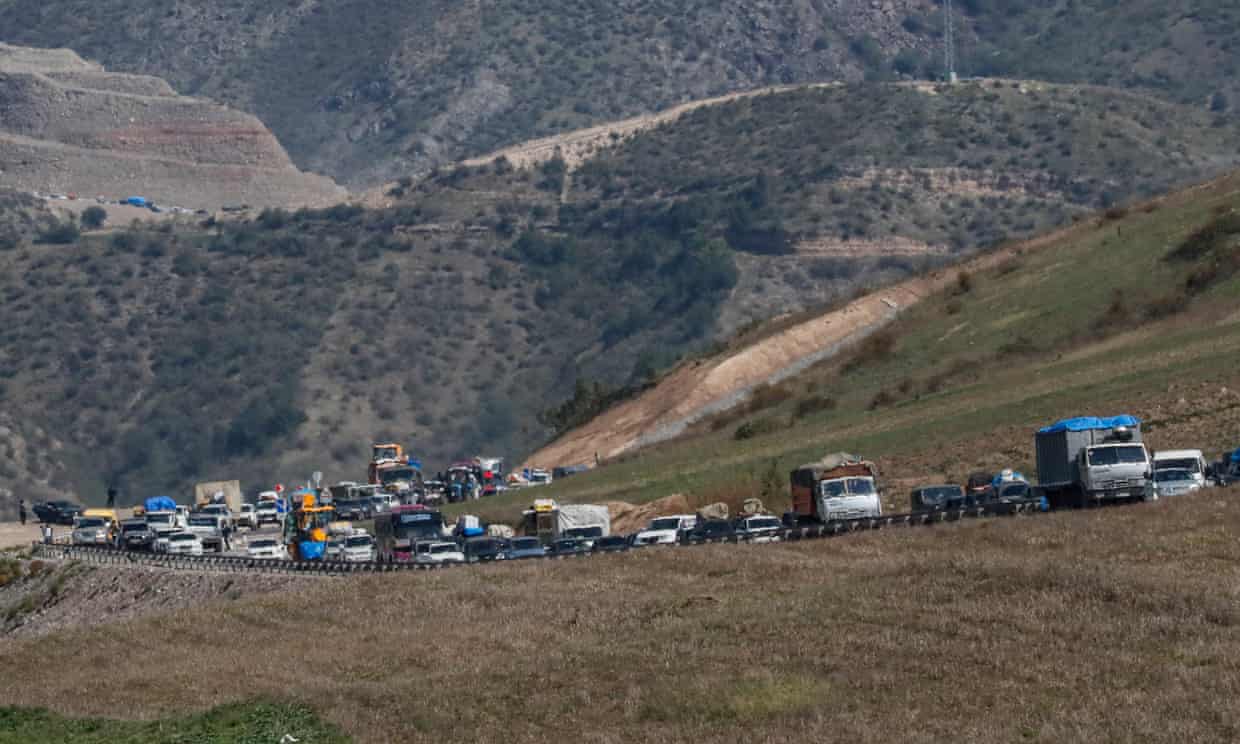As Does Russia, So Do Its Allies
"Initially, it was all about Karabakh and improving their bargaining position and threatening the Armenians’ territorial integrity to deter their support for Karabakh Armenians.""Now, since they have Karabakh under control, they don’t need any agreement with the Armenian government. They might just move forward and say: ‘OK, we have some territory and we take some more. Or just take the whole Syunik region.""It’s part of this maximalist approach: you’re hungry and you never stop eating if no one puts a red line."Stefan Meister, head, Centre for Order and Governance in Eastern Europe, Russia, and Central Asia, German Council on Foreign Relations, Berlin"I left Stepanakert having a slight hope that maybe something will change and I will come back soon.""These hopes are ruined after reading about the dissolution of our government."Ani Abaghyan, 21, student, Nagorno-Karabakh
 |
| Armenians fleeing Nagorno-Karabakh on Friday. Photograph: Anatoly Maltsev/EPA |
Its thirty years of independence as an Armenian enclave recognizing its Armenian-ethic population has failed. Despite a ceasefire brokered by Russia between Armenia and Azerbaijan several years ago, Azerbaijan carried out a lightning offensive last week, reclaiming full control over the region, demanding Armenian troops in Nagorno-Karabakh disarm, while the separatist government was to dissolve itself.
With a larger, better equipped military than that of Armenia, there was little option but for Armenia to agree with the demands. Residents of Nagorno-Karabakh are under no illusions; were they to remain they would become second-class citizens under Azerbaijani rule. Fearing violence yet to come, most of the ethnic Armenians have fled their once-regional capital of Stepanakert, with no longer any hope for the future there.
"We can never go back to our homes without having an independent government in Artaskh", explained layer Anush Shahramanyan, 30, referring to Nagorno-Karabakh by its Armenian name. Sunday began the mass exodus of ethnic Armenians from the mountainous region within Azerbaijan, and by Thursday morning, well over 70,000 people, representing over half of the region's population of Nagorno-Karabakh had fled to Armenia. And nor is the exodus completed, the influx continues as they stream into Armenia.
Following the collapse of the Soviet Union, separatist conflict came to an end in 1994 and Nagorno-Karabakh came under ethnic Armenian forces' control, with Armenia backing them. A six-week war in 2020 saw Azerbaijan taking back parts of the South Caucasus Mountain region, along with surrounding territory claimed earlier by Armenian forces. None of which altered Nagorno-Karabakh's recognition internally as part of Azerbaijan's sovereign geography.
As 2022 ended, Azerbaijan blockaded the sole road connecting Nagorno-Karabakh with Armenia claiming it was being used by the Armenian government as a transit point for illicit weapons shipments to the regional separatist forces. The closure, according to Armenia, denied basic food and fuel supplies to the breakaway region. Armenia's leadership finally distanced itself from the conflict, and with the blockade serving as a siege mechanism, ethnic Armenian forces agreed to surrender arms within 24 hours of Azerbaijan's offensive last week.
"This is a situation where they’ve lived under nine months of blockade. And when they come in, they’re full of anxiety, they’re scared, they’re frightened and they want answers.""We are ready to cope with up to 120,000 people. It’s very hard to predict how many will come at this juncture."Kavita Belani, UNHCR representative in Armenia
 |
| More than 21,000 vehicles carrying refugees have crossed into Armenia Sky News |
Labels: Armenia, Azerbaijan, Conflict, Ethnic Armenians, Exodus, Nagorno-Karabakh